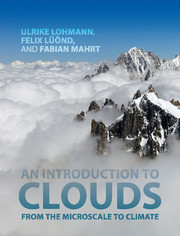Book contents
- Frontmatter
- Dedication
- Contents
- Preface
- List of symbols and acronyms
- 1 Clouds
- 2 Thermodynamics
- 3 Atmospheric dynamics
- 4 Mixing and convection
- 5 Atmospheric aerosol particles
- 6 Cloud droplet formation and Köhler theory
- 7 Microphysical processes in warm clouds
- 8 Microphysical processes in cold clouds
- 9 Precipitation
- 10 Storms and cloud dynamics
- 11 Global energy budget
- 12 Impact of aerosol particles and clouds on climate
- References
- Index
1 - Clouds
Published online by Cambridge University Press: 05 June 2016
- Frontmatter
- Dedication
- Contents
- Preface
- List of symbols and acronyms
- 1 Clouds
- 2 Thermodynamics
- 3 Atmospheric dynamics
- 4 Mixing and convection
- 5 Atmospheric aerosol particles
- 6 Cloud droplet formation and Köhler theory
- 7 Microphysical processes in warm clouds
- 8 Microphysical processes in cold clouds
- 9 Precipitation
- 10 Storms and cloud dynamics
- 11 Global energy budget
- 12 Impact of aerosol particles and clouds on climate
- References
- Index
Summary
Clouds are fascinating to watch for their myriad of shapes. They are also scientifically challenging because their formation requires both knowledge about the large-scale meteorological environment as well as knowledge about the microphysical processes involved in cloud droplet and ice crystal formation.
In this chapter we introduce clouds. In Section 1.1 we highlight their importance for Earth's energy budget and the hydrological cycle. In Section 1.2 we discuss the main cloud types, with their macroscopic properties, as defined by the World Meteorological Organization (WMO), and other, less common cloud types. After this macroscopic description of clouds, we turn to their microphysical properties in Section 1.3.
Definition and importance of clouds
A cloud is an aggregate of cloud droplets or ice crystals, or a combination of both, suspended in air. For a cloud to be visible, the cloud particles need to exist in a sufficiently large concentration. This definition has its origin in operational weather forecasting, where observers indicate the fraction of the sky that is covered with clouds. A more precise definition of cloud cover is used when the information is derived from satellite data, which nowadays provide a global picture of the total cloud cover. Satellites define clouds on the basis of their optical depth, which is the amount of radiation (in our case from the Sun) removed from a light beam by scattering and absorption (Chapter 12).
There are several global cloud climatologies; most of them derived from satellite data, so-called satellite retrievals (Stubenrauch et al., 2009). In the global annual average, roughly 70% of Earth's surface is covered with clouds. The cloud cover is 5%–15% higher over oceans than over land (Table 1.1). The oldest satellite data are from the International Satellite Cloud Climatology Project (ISCCP) (Rossow and Schiffer, 1999), which has cloud information dating back to 1983. The ISCCP satellite picture (Figure 1.1) shows that clouds cover more than 90% of the sky in the storm tracks of the Southern Ocean and the semi-permanent Aleutian and Icelandic low pressure regions in the north Pacific and north Atlantic, respectively, as shown in Figure 1.2.
Information
- Type
- Chapter
- Information
- An Introduction to CloudsFrom the Microscale to Climate, pp. 1 - 25Publisher: Cambridge University PressPrint publication year: 2016
